Vancouver Canucks: Top 5 Questionable Moves by Jim Benning

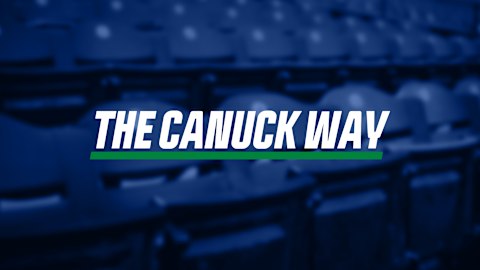
The Vancouver Canucks are struggling in every aspect this season, and part of it is because of missed opportunities from the front office.
A month into the season, and things haven’t gone according to plan for the Vancouver Canucks.
The team cannot score, the defence isn’t much more reliable than it was last season and the goaltending situation remains mediocre at best. This isn’t what GM Jim Benning and co. had in mind when they signed winger Loui Eriksson and traded for defenceman Erik Gudbranson. But right now, the Canucks are showing they could be worse than last season’s forgettable campaign.
The Canucks’ refusal to tear it all down and restart has come to hurt them. They’ve shown that rebuilding on the fly isn’t possible. You can’t get younger and stock up on prospects when you keep signing or trading for guys on the wrong side of 30.
The Detroit Red Wings have also tried the same model. Sure, they’ve found ways to keep their playoff streak in tact, but this team isn’t anywhere close to contention. Ken Holland traded away far too many first-round picks, and you can’t rely on finding late-round gems each season.
Until the Canucks finally commit to a full-on rebuild, there’s not much of a reason to think they’ll make noise in the playoffs.
Here are the five most questionable moves by Benning that left us wondering “why”?
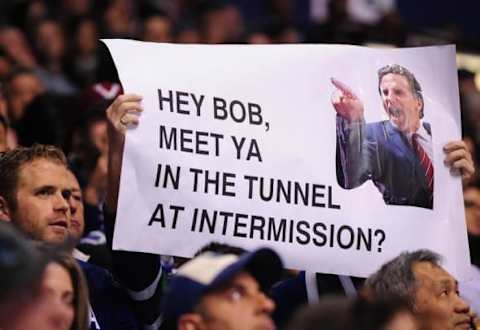
5. 2014 Offseason
The Canucks were coming off of an embarrassing season under John Tortorella that saw them miss the playoffs for the first time in six years. They were among the NHL’s worst teams, there were more empty seats than ever before at Rogers Arena and it was clear the locker room was a toxic mess.
So, the Canucks decided to kick off a new era. GM Mike Gillis was fired and replaced by Benning. Tortorella was let go and replaced by Willie Desjardins. Canucks legend Trevor Linden was also hired to be the main man in the front office. After the team selected Jake Virtanen sixth overall, many believed this was the sign of a rebuild.
Instead, the Canucks chose to sign goaltender Ryan Miller to a three-year deal worth $18 million. The fact they traded away a proven Cory Schneider a year earlier made this deal a head-scratcher. Why sign a past-his-prime veteran on a rebuilding team?
The Canucks also added winger Radim Vrbata to a two-year deal worth $10 million. The Canucks did make the playoffs that season, but went out in the first round.
If they simply ignored signing two veterans on the wrong side of 30, the Canucks would have likely been one of the NHL’s worst teams in 2014-15. That could have meant another top-10 pick and finally signal a rebuild. Vrbata’s final season in Vancouver was a disaster, and the Canucks are still holding onto Miller, who’s taking up a big portion of their cap space.
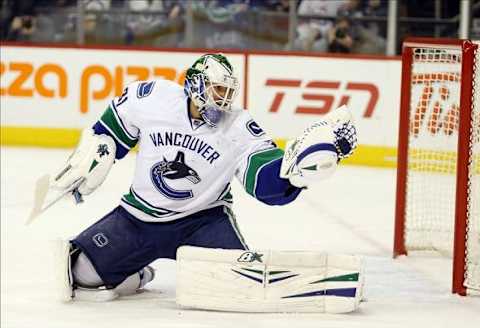
4. Trading Eddie Lack
The Vancouver Canucks brought up Lack in the 2013-14 season to back up Roberto Luongo after Schneider was traded months earlier. Lack, on a very messy Canucks squad, went 16-17-5 with a 2.41 goals-against average and .912 save percentage with four shutouts. That came on one of the NHL’s worst teams with no superstars.
There was a lot to like about this kid’s future with the Canucks.
More from Editorials
- Which team won the Bo Horvat trade?
- What to expect from newcomers Anthony Beauvillier, Aatu Räty
- Back to the future: How the skate uniforms became a regular Canucks’ feature night
- Canucks kick off 2023 with disappointing 6-2 loss to Islanders
- 2nd period penalty trouble sinks Canucks in 4-2 loss against Winnipeg
With Miller hurt during the team’s run to the playoffs in 2014-15, Lack stepped in just fine. His hot play down the stretch got Vancouver into the postseason. He went 18-13-4 with a 2.45 goals-against average and .921 save percentage.
The Canucks, for reasons unknown, decided it was time to trade Lack. They didn’t even try selling him high, letting teams know they were looking at non-first-round picks. Benning traded him to the Carolina Hurricanes for a third and seventh-round pick in that offseason.
If the Canucks wanted to trade a goalie, it should have been Miller. Lack was quietly carrying this team and showing his worth as a No. 1 goalie. Better yet, they could have held on to Lack for another season and get more value for him. Instead, they traded him for very little when his value was only getting higher.

3. Keeping Dan Hamhuis and Radim Vrbata
Unlike the 2014-15 season, the Vancouver Canucks were far out of the playoff race by the time the trade deadline rolled around in 2016. The Canucks had a pair of quality trade chips in veteran blueliner Dan Hamhuis and Vrbata. It was a weak trade market, so the Canucks could have fetched a couple of young assets.
Just about everybody expected Jim Benning to trade away Hamhuis and Vrbata, and it wasn’t because of their ages (33 and 34, respectively). Both were set to become free agents at season’s end, and it didn’t make sense to keep either for the remainder of the season.
But when it was trade deadline day, Benning didn’t trade either of them. Hamhuis could have gone to Boston, but apparently didn’t want to go there because he didn’t consider them a Cup contender:
Hamhuis said last night that going to a contender was top priority to waive NMC. #Bruins don't fit.
— Dan Murphy (@sportsnetmurph) February 29, 2016
The Canucks and Dallas Stars (Hamhuis’ current team), were close to a deal, but the Stars made a trade for Kris Russell of the Calgary Flames at the last minute.
We don’t know exactly what the Canucks would have receiver for either guy, but even a pair of seventh-round selections for the two would have been better than nothing. It just made zero sense for a bottom-five team to hold on to a pair of veterans that weren’t re-signing.
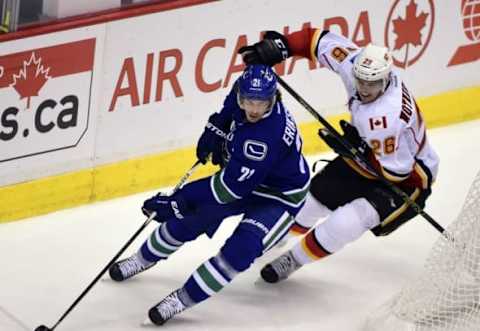
2. Signing Loui Eriksson
This was a classic example of “it seemed like a good idea at the time.”
The Canucks were the NHL’s third-worst team of 2015-16, but didn’t get to draft until fifth overall. As a result, Auston Matthews and Patrik Laine weren’t going to go to Vancouver to give this team a much-needed boost of offence.
So, Benning signed Swedish star Loui Eriksson to a six-year deal worth $36 million. The 31-year-old was coming off a 30-goal, 63-point season with the Boston Bruins. Pairing him with the Sedins was a match made in Heaven, on paper.
But, Eriksson has struggled mightily in Vancouver. The two-way forward scored just two goals and six points with a minus-four rating through his first 16 games. Even if Eriksson was the NHL’s top scorer through those first 16, this contract wouldn’t make much sense.
A team that has too many core players on the wrong side of 30 needs to get younger, not older. Eriksson’s contract won’t expire until he’s 37. There’s a good chance the Canucks are only getting three quality years out of this from Eriksson.
There’s no denying that Eriksson is a talented player. But assuming Bo Horvat, Jake Virtanen, Thatcher Demko, Olli Juolevi and Brock Boeser all become NHL regulars and need new contracts down the road, Eriksson will be taking up significant cap space.
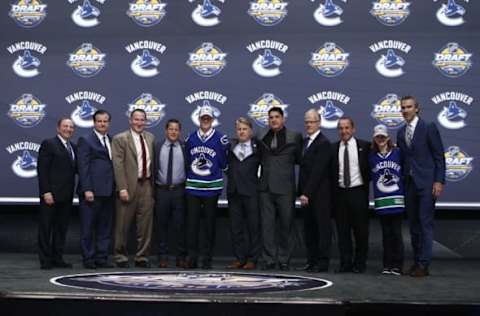
1. Ignoring an inevitable rebuild
More from The Canuck Way
- Which team won the Bo Horvat trade?
- What to expect from newcomers Anthony Beauvillier, Aatu Räty
- Back to the future: How the skate uniforms became a regular Canucks’ feature night
- Canucks kick off 2023 with disappointing 6-2 loss to Islanders
- 2nd period penalty trouble sinks Canucks in 4-2 loss against Winnipeg
When Benning inherited a mess left by his predecessor in Mike Gillis, there was a lot of work to be done. The Sedin twins were entering their age-34 seasons. Ryan Kesler got his trade request and went to the Anaheim Ducks. But instead of possibly parting with the Sedins, Kevin Bieksa, Alex Edler and/or Alex Burrows while their values were high, Benning and the Canucks decided to take an aim at the playoffs.
Sure, it was an entertaining season in 2014-15, where they reached the playoffs after a surprise second-place finish in the Pacific Division. But looking back now, it took the Canucks nowhere. What if they simply started a rebuild? They would have likely been among the draft lottery teams that could have won Connor McDavid or Jack Eichel.
Even after last season’s letdown, the Canucks could have rebuilt. The Sedin twins had high value, Alex Burrows could have been bought out, Ryan Miller could have been traded and signing Loui Eriksson wasn’t a necessity.
Next: Nolan Patrick Not the Only Reason to Tank
The Canucks have been experimenting with a rebuild-on-the-fly project that is now entering year four. Maybe Benning isn’t getting a green light from ownership or his boss, Trevor Linden, to tear it all down.
But something has got to give. Benning’s moves haven’t been as backfiring as Gillis’, but they haven’t been successful, either.